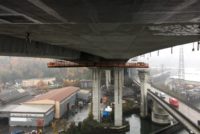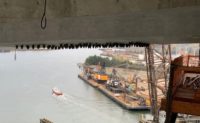The West Seattle Bridge emergency is over. The Seattle Dept. of Transportation (SDOT) announced it will reopen the city's critical transportation link on Sunday, Sept. 18. The seven-lane, 2,600-ft-long, 38-year-old high-rise bridge was shut down in March 2020 after regular inspections conducted by WSP indicated accelerated growth of new and existing structural cracks. During the emergency $67-million project, crews worked to stabilize and repair the bridge.
Kraemer North America, hired under an emergency contract to stabilize the structure, injected epoxy into cracks, added external post-tensioning to support the existing internal post-tensioning system, wrapped concrete girders with carbon fiber-reinforced polymer and released the damaged bearing at Pier 18.
"We have completed our analysis of strength tests conducted earlier this week on the West Seattle Bridge, and the bridge has passed its final safety test," SDOT said in a statement. "This data confirms the bridge is strong, safe and ready to reopen on Sunday, Sept. 18, as planned."
According to SDOT, the span is the city's most-used bridge, carrying an average of more than 100,000 cars, trucks and buses every day. Its closure has caused significant disruption to traffic, officials say.
Earlier in the week, SDOT conducted load testing on the bridge to confirm the repairs completed over the past 2.5 years were sufficient. The testing process involved driving up to a dozen 80,000-pound trucks on the bridge deck, then actively measuring the bridge's response to the added weight using a new bridge monitory system.
The load testing was the final step in the reopening process. The heaviest load the bridge supports is the weight of the structure, with this dead load accounting for about 80% of all weight. The remaining 20% live load signifies the traffic weight of cars, trucks and buses. During the final testing, the trucks were strategically placed on the bridge at one time to create a variety of traffic load scenarios.
"During each scenario, the monitoring system sensors and temporary sensors placed for load testing tracked whether the bridge was responding as expected," SDOT says.
"The bridge is stronger and safer now that we have repaired cracking and added nearly 60 miles of steel cable backbone to the bridge, 100,000 sq ft of carbon-fiber wrapping and 240 gallons of epoxy to fill cracks in the bridge's concrete," SDOT stated. "We are confident that the repaired bridge will stand strong for decades to come, fulfilling its original intended lifespan."
The new bridge monitoring system is the most extensive used in the city and will run continuously, automatically alerting engineers of any subtle movements or growth of existing cracks.
While the $67 million in repairs focused on the 140-ft-tall High Bridge, SDOT also spent part of the appropriated $175 million to conduct preventative maintenance on the Low Bridge by injecting epoxy into cracks and adding carbon-fiber wrapping on both the interior and exterior concrete surfaces of the swing spans. Other improvements include a controls system upgrade and refurbishment of the hydraulic cylinders that help the bridge swing open. Both bridges were in the same contract to improve efficiency in coordination and scheduling.
Once the bridge closed in March 2020, SDOT installed new intelligent monitoring system with the help of WSP engineers and embedded sensors into all three bridge spans to identify movement or crack growth. The bridge has responded as expected during major heatwaves and freezing winter storms.
SDOT says the repairs to the West Seattle Bridge are expected to help the structure reach its expected 80-year lifespan, lasting for another 42 years.





